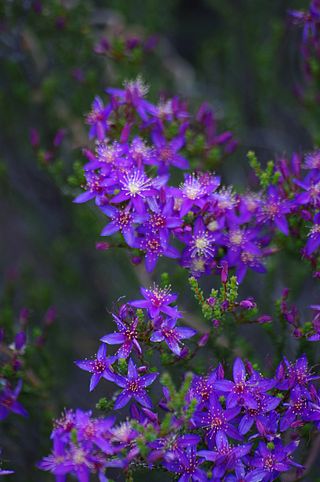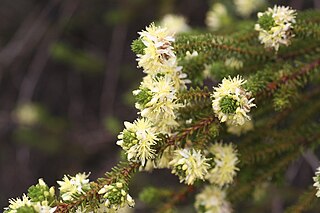
Calytrix aurea is a species of flowering plant in the myrtle family Myrtaceae and is endemic to the south-west of Western Australia. It is a shrub with elliptic, lance-shaped or linear leaves and clusters of yellow flowers with 25 to 55 yellow stamens in several rows.

Calytrix leschenaultii is a species of flowering plant in the myrtle family Myrtaceae and is endemic to the Southwest Australia of Western Australia. It is a mostly glabrous shrub with egg-shaped, elliptic, lance-shaped or linear leaves and purple, mauve, violet or pink flowers with a white or yellow base, and 6 to 40 white or yellowish stamens.

Calytrix achaeta, commonly known as the white-flowered turkey bush, kerosene wood or fringe-myrtle, is a species of flowering plant in the myrtle family Myrtaceae and is endemic to north-western Australia. It is a shrub or tree with hairy branchlets, egg-shaped, linear or lance-shaped leaves, and white to cream-coloured flowers with 12 to 18 stamens in a single row.

Calytrix acutifolia is a species of flowering plant in the myrtle family Myrtaceae and is endemic to south-west of Western Australia. It is a slender, openly-branched shrub with linear to lance-shaped leaves and clusters of white, cream-coloured or yellow flowers with 40 to 85 white stamens in several rows.

Calytrix asperula, commonly known as brush starflower, is a species of flowering plant in the myrtle family Myrtaceae and is endemic to the south of Western Australia. It is a mostly glabrous shrub with linear to narrowly elliptic leaves and cream-coloured to yellow flowers with 40 to 60 yellow stamens in several rows.

Calytrix brevifolia is a species of flowering plant in the myrtle family Myrtaceae and is endemic to the west of Western Australia. It is a glabrous shrub with egg-shaped, linear, elliptic or more or less round leaves and clusters of pink to magenta flowers with about 40 to 90 yellow stamens in 4 rows.
Calytrix breviseta is a species of flowering plant in the myrtle family Myrtaceae and is endemic to the south-west of Western Australia. It is a more or less glabrous shrub with egg-shaped, elliptic, lanceolate, oblong or linear leaves and clusters of purple flowers with about 25 to 65 white stamens in several rows, becoming reddish-purple as they age.

Calytrix chrysantha is a species of flowering plant in the myrtle family Myrtaceae and is endemic to the south-west of Western Australia. It is a glabrous shrub usually with oblong to linear leaves and clusters of yellow flowers with about 45 to 55 yellow stamens in several rows.
Calytrix divergens is a species of flowering plant in the myrtle family Myrtaceae and is endemic to inland areas of Western Australia. It is a mostly glabrous shrub with egg-shaped, lance-shaped or oblong leaves, and yellow flowers with about 40 to 80 stamens in several rows.

Calytrix drummondii is a species of flowering plant in the myrtle family Myrtaceae and is endemic to the Geraldton Sandplains bioregion of Western Australia. It is a glabrous shrub with linear leaves, and yellow flowers with about 55 to 85 yellow stamens in several rows.

Calytrix duplistipulata is a species of flowering plant in the myrtle family Myrtaceae and is endemic to inland areas of Western Australia. It is a glabrous shrub with elliptic to egg-shaped or oblong leaves, and pink to purple flowers with about 9 to 16 stamens in a single row.
Calytrix eneabbensis is a species of flowering plant in the myrtle family Myrtaceae and is endemic to the south-west of Western Australia. It is a glabrous shrub with lance-shaped leaves and purple and yellowish flowers with 40 to 60 stamens in several rows.
Calytrix erosipetala is a species of flowering plant in the myrtle family Myrtaceae and is endemic to inland areas of Western Australia. It is a glabrous shrub with spreading lance-shaped to egg-shaped or linear leaves, and white to pink flowers with about 18 to 24 stamens in a single row.

Calytrix formosa is a species of flowering plant in the myrtle family Myrtaceae and is endemic to the west of Western Australia. It is a glabrous shrub with erect, elliptic, broadly elliptic or oblong leaves, and pink flowers with about 90 to 105 stamens in multiple rows.
Calytrix gypsophila, commonly known as gypsum fringle-myrtle, is a species of flowering plant in the myrtle family Myrtaceae and is endemic to southern continental Australia. It is a glabrous shrub with oblong, linear or lance-shaped leaves with the narrower end towards the base, and white flowers with 25 to 40 stamens in a single row.

Calytrix nematoclada is a species of flowering plant in the myrtle family Myrtaceae and is endemic to the south-west of Western Australia. It is a shrub with decussate, narrowly elliptic to egg-shaped leaves and purple or deep pink flowers with about 35 to 40 stamens in three rows.
Calytrix parvivallis is a species of flowering plant in the myrtle family Myrtaceae and is endemic a restricted area in the south-west of Western Australia. It is a shrub with decussate, narrowly elliptic leaves and purple flowers with about 45 to 50 stamens in three rows.
Calytrix paucicostata is a species of flowering plant in the myrtle family Myrtaceae and is endemic to a restricted area in the west of Western Australia. It is a shrub with linear leaves and bright to rich pink flowers with about 75 to 88 stamens in several rows.
Calytrix merralliana is a species of flowering plant in the myrtle family Myrtaceae and is endemic to inland areas of Western Australia. It is a glabrous shrub with linear to elliptic leaves and violet flowers with about 45 to 55 yellow stamens in several rows.

Calytrix oldfieldii is a species of flowering plant in the myrtle family Myrtaceae and is endemic to the south-west of Western Australia. It is a glabrous shrub with linear, oblong or egg-shaped leaves and mauve, pink, red, magenta or violet flowers with about 50 to 75 yellow stamens in several rows.












